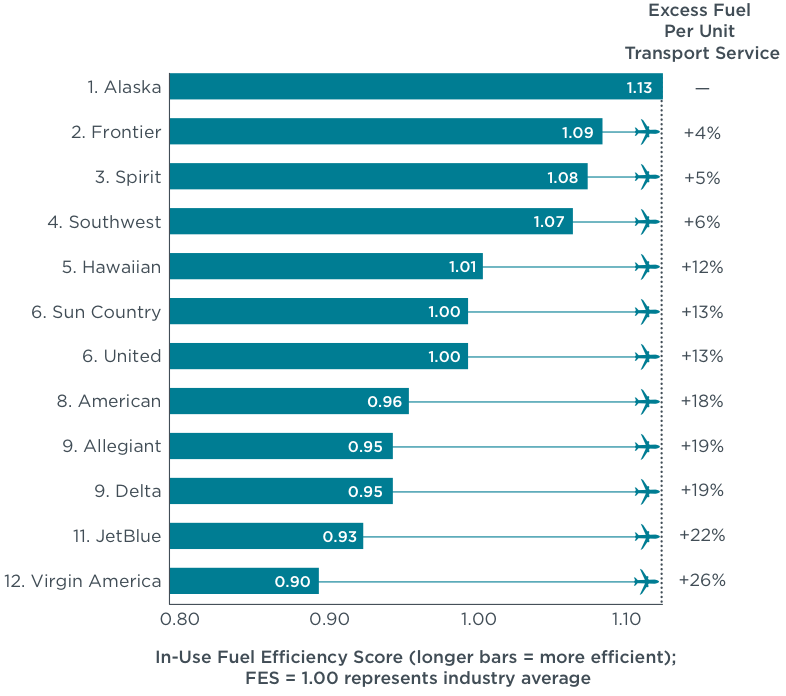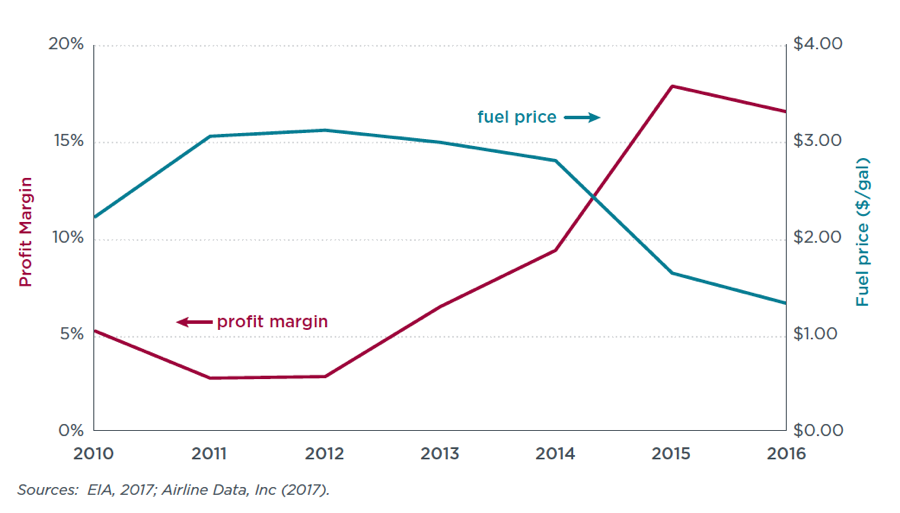Press release
Profits and carbon emissions surge for U.S. domestic airlines
Low fuel prices and high travel demand undercut overall fuel-efficiency gains in aircraft operations in 2015 and 2016, study finds
Annual fuel-efficiency ranking of domestic carriers shows Alaska Airlines on top again, persistent gap between best and worst performers
A sharp increase in revenue passenger miles (RPM) drove both profits and fuel consumption on domestic operations up between 2014 and 2016 for U.S. airlines, according to a study released today by the International Council on Clean Transportation (ICCT). Alaska Airlines ranked first in overall fuel-efficiency among US carriers for seventh year in a row, while the gap between it and the least fuel-efficient carrier, Virgin America in 2016, widened slightly to 26%.
Since 2012, the average profit margin for domestic carriers has increased nearly sixfold, from 3% to 17% in 2016, thanks to lower fuel prices and higher ancillary fees. Compared to 2012, U.S. domestic carriers saved about $17 billion in fuel costs last year, about 20% of which were devoted to lower fares for passengers.
“Alaska burns about 13% less fuel than the industry average, it’s a profitable airline, and it’s done this for seven years running,” said ICCT’s Naya Olmer, lead author of the study. “So, it’s possible. But industrywide, demand is swamping energy-efficiency improvements, and emissions are spiking as a result.”
Between 2014 and 2016, overall revenue passenger miles on domestic operations rose by 10% for U.S. carriers. That growth outstripped a 3% overall improvement in fuel efficiency (measured in RPMs per gallon of fuel), causing fuel use and CO2 emissions to jump by 7%.
The ICCT ranked U.S. carriers by fuel-efficiency each year from 2010 to 2014. Like those studies, the 2015-2016 ranking uses a deterministic frontier model to equitably compare the efficiencies of airlines operating under different business models. Alaska, Frontier, and Spirit lead as the most fuel-efficient carriers in 2016. These airlines increase fuel efficiency with cleaner fleets, higher load factors, denser seating configurations, and other strategies. Virgin America ranks as least-efficient airline in 2015 and 2016, burning 26% more fuel than comparable Alaska flights in 2016.
Aviation is a major contributor to climate pollution, accounting for about 2.5% of global CO2 emissions—30% of which is attributable to US aircraft alone. And aviation’s share of global carbon emissions is growing: the Federal Aviation Administration projects that aviation activity will increase 2% to 3% annually through 2037.
“With airline profits surging, we need to explore environmental and consumer protections if the U.S. is going to cap aviation carbon emissions from 2020 as it has committed to do,” said Dan Rutherford, ICCT’s aviation program director and co-author of the paper. In 2015, the U.S. government set an aspirational goal of capping CO2 emissions from U.S. commercial carriers at 2005 levels from 2020.
Contacts:
Dan Rutherford, 415.202.5747, dan@theicct.org
Naya Olmer, n.olmer@theicct.org
Publication details:
U.S. domestic airline fuel efficiency ranking, 2015–2016 (.pdf)
Download: http://theicct.org/publications/us-domestic-airline-fuel-efficiency-ranking-2015-16


